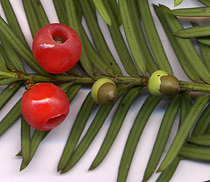
Picture of the has been licensed under a GFDL
Original source: l'arille est toxic pour l'homme. En revanche, la graine n'est pas nuisible à la santé. Si vous machez de l'arille, elle aura un gout sucré et tendre. Vous saurez alors la distinguez. La taxine contenu dans l'arille, présente quelques symptomes si vous la digérez: Au bout de 1 à 3 heures, vous sentirez que votre respiration bloque. votre coeur se ralentira.Le manteau de la graine avalée intacte résiste aux sucs digestifs de l’estomac et de l’intestin et la graine est éliminée sans libérer de taxine. Elle a, dans un premier temps, une action stimulante et ensuite paralysante. Outre la taxine, l’if contient également des huiles volatiles responsables d’une irritation de l’estomac et des intestins.
Permission: GNU Free Documentation License
Original source: l'arille est toxic pour l'homme. En revanche, la graine n'est pas nuisible à la santé. Si vous machez de l'arille, elle aura un gout sucré et tendre. Vous saurez alors la distinguez. La taxine contenu dans l'arille, présente quelques symptomes si vous la digérez: Au bout de 1 à 3 heures, vous sentirez que votre respiration bloque. votre coeur se ralentira.Le manteau de la graine avalée intacte résiste aux sucs digestifs de l’estomac et de l’intestin et la graine est éliminée sans libérer de taxine. Elle a, dans un premier temps, une action stimulante et ensuite paralysante. Outre la taxine, l’if contient également des huiles volatiles responsables d’une irritation de l’estomac et des intestins.
Permission: GNU Free Documentation License

Picture of the has been licensed under a Creative Commons Attribution-Share Alike.
Permission: Some rights reserved
Permission: Some rights reserved
Common Yew
It is a small- to medium-sized evergreen tree, growing 10–20 metres tall, with a trunk up to 2 metres diameter. The bark is thin, scaly brown, coming off in small flakes aligned with the stem. The leaves are lanceolate, flat, dark green, 1–4 centimetres long and 2–3 millimetres broad, arranged spirally on the stem, but with the leaf bases twisted to align the leaves in two flat rows either side of the stem, except on erect leading shoots where the spiral arrangement is more obvious. The leaves are highly poisonous.English: The oldest Taxus baccata in Poland and maybe in Central-East Europe, located in Henryków Luba?ski. More
Taxus baccata is a conifer native to western, central and southern Europe, northwest Africa, northern Iran and southwest Asia. It is the tree originally known as yew, though with other related trees becoming known, it may be now known as the common yew, or European yew. More
The foliage of Taxus baccata in detail. More
